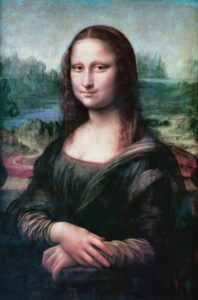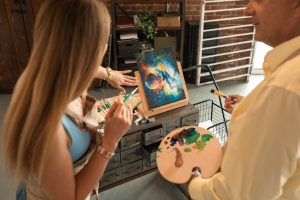
Art is a diverse and ever-evolving field that continually pushes boundaries and challenges the conventional norms. In this quest for innovation, artists are constantly seeking new mediums to express their creativity. One such medium that has gained significant traction in recent years is PVC tarpaulin (Source: PVC Plane). This versatile material has become an indispensable tool in crafting artistic masterpieces. From paintings to outdoor installations, PVC tarpaulin offers a range of benefits that elevate the artistic process and end results.
Definition of PVC Tarpaulin
PVC tarpaulin, also known as polyvinyl chloride tarpaulin, is a synthetic fabric made from polyvinyl chloride polymer. It is commonly used for various purposes, such as waterproof covers, tents, and truck curtains. However, its potential as an art medium has gained recognition in the creative community.
Importance of PVC Tarpaulin in Art
Artists are constantly exploring new materials and techniques to express their vision. PVC tarpaulin provides them with a unique canvas that opens up a world of possibilities. Its inherent properties make it an ideal choice for creating captivating and durable artworks.
Versatility of PVC Tarpaulin
- Use as a Canvas for Paintings
PVC tarpaulin serves as an excellent alternative to traditional canvases. Its smooth texture and ability to hold paint make it an attractive choice for painters. The fabric allows artists to experiment with various mediums, including acrylics, oils, and spray paints. The vibrant colors and intricate details achieved on PVC tarpaulin add depth and dimension to the artwork.
- Creation of Banners and Signage
Beyond traditional paintings, PVC tarpaulin finds its utility in the creation of banners and signage. Its robust nature ensures durability, making it suitable for both indoor and outdoor displays. Artists can showcase their work on a grand scale, capturing the attention of passersby and effectively conveying their message.
- Outdoor Art Installations
PVC tarpaulin’s resistance to weather conditions makes it an ideal choice for outdoor art installations. From large-scale sculptures to temporary installations, this material withstands the elements, including rain, wind, and UV rays. Its flexibility allows artists to manipulate it into various forms, enabling the creation of immersive experiences for viewers.
Durability and Weather Resistance
- Ability to Withstand Harsh Weather Conditions
PVC tarpaulin is renowned for its durability and ability to withstand extreme weather conditions. Unlike traditional canvases that may deteriorate over time, PVC tarpaulin remains intact, ensuring the longevity of artworks. Artists can exhibit their creations with confidence, knowing they will endure the test of time.
- Longevity of PVC Tarpaulin in Artistic Projects
Artists invest significant time and effort into their creations, and preserving them is paramount. PVC tarpaulin’s resistance to fading and tearing ensures that artworks maintain their visual appeal for years to come. This durability adds value to the artistic process, allowing artists to leave a lasting impact on audiences.
- Cost-effectiveness
Affordability Compared to Traditional Art Materials
Art supplies can be expensive, especially for aspiring artists. PVC tarpaulin offers a cost-effective alternative to traditional canvases. Its affordability allows artists to allocate their budget to other essential materials while still producing high-quality artworks. This accessibility democratizes art, making it more inclusive and attainable.
- Reusability and Cost-saving Benefits
PVC tarpaulin’s reusability is another significant advantage. Artists can repaint or repurpose the material, giving it new life and minimizing waste. This sustainability factor not only reduces environmental impact but also saves costs in the long run. The ability to reuse PVC tarpaulin makes it an attractive choice for both emerging and established artists.
- Customizability and Size Options
Availability of Various Sizes and Shapes
PVC tarpaulin is available in a wide range of sizes and shapes, allowing artists to select the perfect canvas for their creative vision. From small-scale paintings to large murals, this versatility caters to the diverse needs of artists. Custom sizes can also be easily obtained, ensuring a tailored experience.
Personalization and Customization Possibilities
Artists value the ability to personalize their artworks, and PVC tarpaulin facilitates this customization. The material can be easily cut, stitched, and combined with other materials, enabling artists to create unique compositions. This versatility enhances artistic expression and encourages experimentation.
Easy Maintenance and Transportation
- Cleaning and Care of PVC Tarpaulin
Maintaining PVC tarpaulin artworks is a straightforward process. The material can be cleaned using mild soapy water and a soft cloth. This easy maintenance ensures that artworks remain vibrant and presentable over time. Additionally, the fabric’s resistance to stains and moisture adds to its longevity.
- Portability and Lightweight Nature
Artists often need to transport their artworks for exhibitions or installations. PVC tarpaulin’s lightweight nature makes it convenient for transportation. It can be easily rolled, folded, or packed into compact spaces, reducing the logistical challenges associated with art logistics. Artists can confidently showcase their creations without the added stress of cumbersome transportation.
Sustainability and Environmental Considerations
- PVC Tarpaulin as a Sustainable Art Medium
Sustainability has become a crucial consideration in the art world. PVC tarpaulin offers an environmentally friendly alternative to traditional canvases made from wood or cotton. By utilizing this material, artists contribute to reducing deforestation and minimizing their ecological footprint.
- Eco-friendly Alternatives and Recycling Options
While PVC tarpaulin itself is a durable material, there are eco-friendly alternatives available for artists seeking more sustainable options. Some manufacturers produce PVC tarpaulin made from recycled materials or offer recycling programs for used PVC tarpaulin. Artists can actively participate in the circular economy by opting for these alternatives and recycling their materials responsibly.
Real-world Examples and Success Stories
- Artists and Their Notable Works Using PVC Tarpaulin
Numerous artists have embraced PVC tarpaulin as their preferred medium, resulting in stunning artworks. Renowned names in the art world have successfully incorporated this material into their practices, garnering recognition and acclaim. From bold paintings to intricate installations, PVC tarpaulin has become synonymous with artistic innovation.
- Impact and Recognition in the Art Community
The utilization of PVC tarpaulin has significantly influenced the art community. Artists, critics, and enthusiasts alike appreciate the unique qualities and artistic possibilities it offers. Exhibitions and events showcasing PVC tarpaulin artworks attract attention and spark conversations, contributing to the exploration of new artistic horizons.
Want to learn more about arts? Try reading History of Modern Art Documentary.
PVC tarpaulin has emerged as an essential tool for artists seeking to craft artistic masterpieces. Its versatility, durability, cost-effectiveness, and sustainability make it an attractive choice for artists across various disciplines. By unveiling the canvas of PVC tarpaulin, artists can push boundaries, challenge conventions, and create captivating artworks that leave a lasting impression on audiences.




 The benefits of visualization for artists can be perceived through compelling and creative art works that inspire them to visually express varying emotions. Through the use of lines, forms, shapes, scales, colors, contrast and composition, visually guided artists manipulate those elements in presenting not only their own emotions but also of others who pose as their subjects.
The benefits of visualization for artists can be perceived through compelling and creative art works that inspire them to visually express varying emotions. Through the use of lines, forms, shapes, scales, colors, contrast and composition, visually guided artists manipulate those elements in presenting not only their own emotions but also of others who pose as their subjects. Even during prehistoric periods and through ancient civilizations, industrialization era and the age of computerization, it can be surmised that both artistic and scientific visualizations played a significant role in the advancement of art, science and technology. The continuing use of visualization as a widely used approach is mainly because of the benefits that artists and scientists derive from its use. The most well-received of which are the following:
Even during prehistoric periods and through ancient civilizations, industrialization era and the age of computerization, it can be surmised that both artistic and scientific visualizations played a significant role in the advancement of art, science and technology. The continuing use of visualization as a widely used approach is mainly because of the benefits that artists and scientists derive from its use. The most well-received of which are the following: The convergence of art and technology has revolutionized the way artists create, exhibit, and market their work. Art studios, once seen as traditional spaces, are now embracing cutting-edge technological solutions from yourtechanswers.com to enhance the creative process, streamline operations, and connect with a wider audience.
The convergence of art and technology has revolutionized the way artists create, exhibit, and market their work. Art studios, once seen as traditional spaces, are now embracing cutting-edge technological solutions from yourtechanswers.com to enhance the creative process, streamline operations, and connect with a wider audience.











 Driving is more than just getting from point A to point B—it’s a dynamic art form that requires skill, awareness and a keen sense of anticipation. In this article, we’ll delve into the fascinating world of defensive driving, exploring the techniques and strategies to help us stay safe on the road while embracing the artistry of car control.
Driving is more than just getting from point A to point B—it’s a dynamic art form that requires skill, awareness and a keen sense of anticipation. In this article, we’ll delve into the fascinating world of defensive driving, exploring the techniques and strategies to help us stay safe on the road while embracing the artistry of car control.

 In Brazil, marketing para empresas in any kind of industry can have better results if undertaken by a specialist who has deep understanding of the nation’s culture. Promoting the country’s art industry as an example, as it took years before art became a recognized industry in the relatively young nation.
In Brazil, marketing para empresas in any kind of industry can have better results if undertaken by a specialist who has deep understanding of the nation’s culture. Promoting the country’s art industry as an example, as it took years before art became a recognized industry in the relatively young nation. Although industries have gone global, Brazil’s art is deeply founded on its culture, its traditions and on the sensitivities, discourses and humour of the Brazilian people. The idea is for Brazilian art to have that distinction of being identifiable as Brazilian, created in a style known in the field of art as neoclassism and romanticism.
Although industries have gone global, Brazil’s art is deeply founded on its culture, its traditions and on the sensitivities, discourses and humour of the Brazilian people. The idea is for Brazilian art to have that distinction of being identifiable as Brazilian, created in a style known in the field of art as neoclassism and romanticism. While Brazil’s tax rate on art remains unaccommodating, contemporary Brazilian artists tested the waters by selling their works of art online during the pandemic. The results were phenomenal as it strengthened the moves of virtual galleries and auction houses to continue virtually with the help of digital technology. Actually, the shift to displaying and selling artworks online brought in younger groups of art collectors in Brazil. Apparently, they are the ones highly attuned to the latest technologies that allowed them to lucratively invest in unique and exceptional forms of exotic art as exemplified by the Brazilian neoclassicism style.
While Brazil’s tax rate on art remains unaccommodating, contemporary Brazilian artists tested the waters by selling their works of art online during the pandemic. The results were phenomenal as it strengthened the moves of virtual galleries and auction houses to continue virtually with the help of digital technology. Actually, the shift to displaying and selling artworks online brought in younger groups of art collectors in Brazil. Apparently, they are the ones highly attuned to the latest technologies that allowed them to lucratively invest in unique and exceptional forms of exotic art as exemplified by the Brazilian neoclassicism style. Artists are no strangers to blogging as they can easily give context to their creative works; even welcoming “Submit Your Guest Post” invites extended by other websites. Art bloggers generally feel a need to surround their visual concepts with words. Writing passages can shed light into the emotions and conditions that inspired them to do creative work.
Artists are no strangers to blogging as they can easily give context to their creative works; even welcoming “Submit Your Guest Post” invites extended by other websites. Art bloggers generally feel a need to surround their visual concepts with words. Writing passages can shed light into the emotions and conditions that inspired them to do creative work. Art blogs are not necessarily confined to discourses about a specific artwork up for sale. While topics usually delve on the art blogger’s insights and opinions to demonstrate his or her knowledge and mastery of art creation, the content of guest blogs can be anything from art history to art news, to innovative art techniques, and even about art activism.
Art blogs are not necessarily confined to discourses about a specific artwork up for sale. While topics usually delve on the art blogger’s insights and opinions to demonstrate his or her knowledge and mastery of art creation, the content of guest blogs can be anything from art history to art news, to innovative art techniques, and even about art activism. Spam blogs, also known as splogs are malicious content that have no other purpose but to deploy and spread active links in different websites across the Internet space. Spreading spam blogs containing live backlinks are capable of manipulating the ranking of resources as providers of answers to browser queries.
Spam blogs, also known as splogs are malicious content that have no other purpose but to deploy and spread active links in different websites across the Internet space. Spreading spam blogs containing live backlinks are capable of manipulating the ranking of resources as providers of answers to browser queries. Art has always been a powerful medium for conveying spiritual meanings and ideas. Through paintings, sculptures, or religious symbols, artists have used their creativity to express their beliefs, values, and emotions about the world around them. By understanding the art’s different types of spiritual meanings, we can better appreciate these works’ depth, complexity, and significance to our lives.
Art has always been a powerful medium for conveying spiritual meanings and ideas. Through paintings, sculptures, or religious symbols, artists have used their creativity to express their beliefs, values, and emotions about the world around them. By understanding the art’s different types of spiritual meanings, we can better appreciate these works’ depth, complexity, and significance to our lives.
 Art and SEO may seem like two separate worlds, but they have a lot in common. Both art and SEO require creativity, attention to detail, and a deep understanding of what people want and need. When these two fields are combined, businesses can reap the benefits of a powerful marketing tool that drives results. In this article, we’ll discuss the role of an art and SEO consultant in improving a business’s online presence.
Art and SEO may seem like two separate worlds, but they have a lot in common. Both art and SEO require creativity, attention to detail, and a deep understanding of what people want and need. When these two fields are combined, businesses can reap the benefits of a powerful marketing tool that drives results. In this article, we’ll discuss the role of an art and SEO consultant in improving a business’s online presence.



